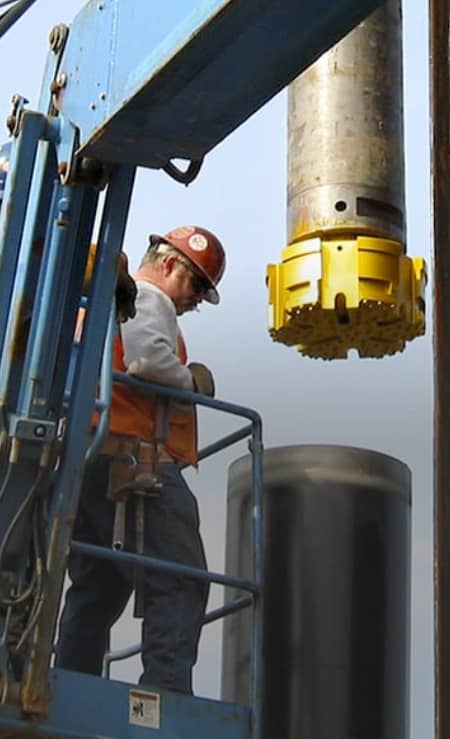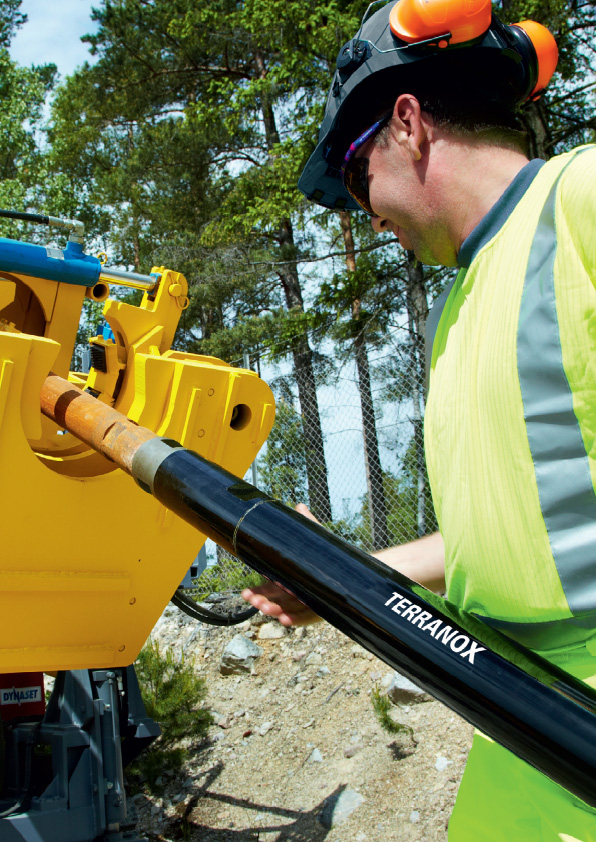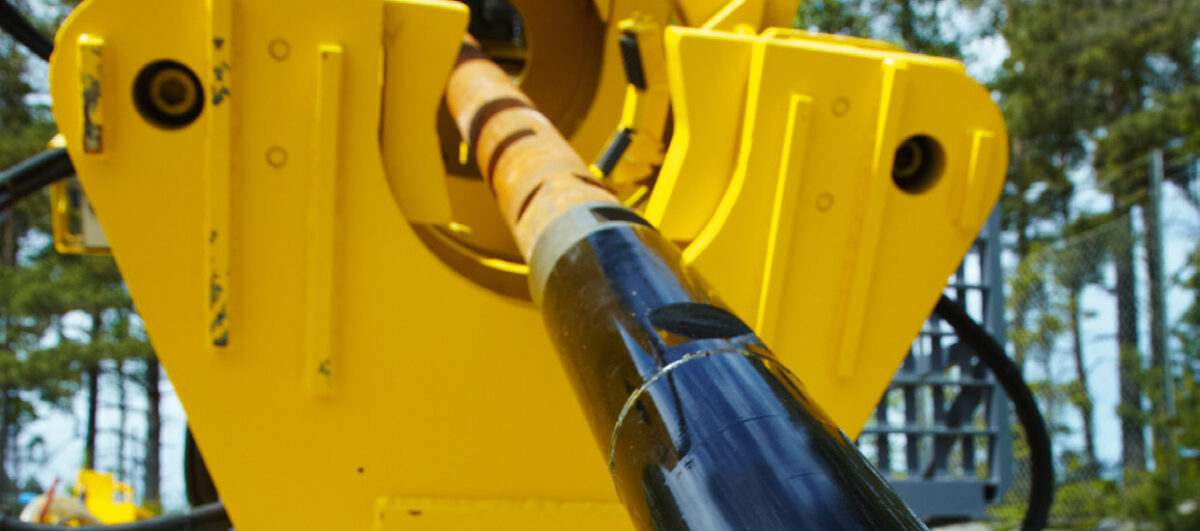As urban redevelopment projects continue to rise, this poses an extra challenge for geotechnical engineers – how can these works be done without damaging surrounding buildings? To meet increasingly specific requirements for foundation works and drilling operations, specialized solutions have become ever more important. One of the most commonly used tools in the drilling industry to meet such challenging scenarios is the Down the Hole Hammer (DTH hammer).
The Impact of DTH Hammers

DTH hammers are most used in hard rock formations and are designed to tackle complex tasks like drilling in populated areas without putting existing structures at risk. In these areas, they are ideal for drilling large diameter boreholes in hard rock formations, typically ranging from 3 inches (85mm) to 48 inches (1219mm) or more.
Another advantage is that DTH hammers can achieve greater depths drilling in hard rock than other methods. Depending on the size of the hammer and the rock formation being drilled, DTH hammers can achieve depths of up to 1,000 feet (305 meters) or more.
DTH hammers therefore offer drilling efficiencies with a high rate of penetration (ROP). This is down to the fact that the air-powered hammer consistently minimizes energy loss to the drill bit, allowing it to break down the rock efficiently. Additionally, the compressed air flushes out the cuttings, reducing the likelihood of clogging or binding the drill bit.
High pressure air is often necessary for efficient flushing of the bit – but caution is required when working with overburden ground where unconsolidation can compromise existing foundation stability.
Drilling in sensitive areas
Urban redevelopment projects present unique challenges and drilling in these sensitive areas can be particularly difficult. One of the key challenges faced by drillers is the need to minimize disturbance to the surrounding environment while drilling. This is where low pressure Down the Hole (DTH) hammers come in.
In urban development projects, it is essential to minimize noise and vibration levels to avoid disturbing nearby residents, buildings, and infrastructure. These hammers use a low air pressure range of around 12 to 18 bar, which is significantly lower than the pressure used by conventional high-pressure DTH hammers. This means that they produce less noise and vibration and cause less ground disturbance during drilling.
Using low pressure DTH hammers allows drillers to work in areas where conventional drilling techniques may not be suitable. This makes low pressure DTH hammers an excellent option for drilling in densely populated areas or areas where there is sensitive infrastructure, such as hospitals, schools, or historic buildings.
Another benefit of low pressure DTH hammers is their ability to drill through a wide range of soil types. Whether it is hard rock or soft soil, low pressure DTH hammers can provide efficient and effective drilling without causing significant ground disturbance. This enables drillers to use a single drilling method for all types of soil conditions, reducing the need to switch between drilling methods, and minimizing the time required for drilling.
Low-pressure DTH hammers have gained in popularity in recent years because they are ‘gentler’ on the ring bit sets compared to high-pressure hammers. This is because low-pressure hammers operate at a lower frequency and produce less impact energy, resulting in reduced wear and tear on the ring bit sets. Being more efficient and requiring less air consumption, makes them cost-effective and environmentally friendly. Engineers should consider using low-pressure DTH hammers in their drilling operations to improve drilling performance and reduce maintenance costs.
Furthermore, low pressure DTH hammers can be used to drill deeper and wider holes, which can be advantageous for foundation and pile construction in urban developments. This is because they provide better penetration rates, ensuring that drilling is completed faster and more efficiently. This can be especially important in urban areas where construction schedules are often tight, and delays can be costly.
Terranox
TerraRoc provides a wide range of highly effective and efficient drilling equipment, including the most productive DTH hammers in the world.
Its Terranox revolutionary line of DTH hammers is engineered specifically for drilling in built-up urban settings. A range of hammers that deliver cost efficient, reliable geological drilling with outstanding performance in low pressure operations.

The Terranox hammer is based on reliable, trusted technology spanning three decades in the industry. They are renowned as rugged and can be easily replaced or rebuilt – perfect for urban areas with restricted drilling hours. Combined with TerraRoc’s global service network to ensure parts and support can be accessed quickly, this cost-effective solution will get the job done efficiently.
Terranox is part of a comprehensive, in-house turnkey package for geotechnical drilling in urban redevelopment projects. The DTH hammers are designed to work seamlessly with TerraRoc’s casing advancement systems Symmetrix, Elemex and Odex to ensure safe and reliable results.
With five sizes available, finding the right hammer is defined by hole size and the ground drilling conditions. Just match the hammer as closely as possible to the required hole size, leaving sufficient space to allow the cuttings to leave the hole.
Terranox hammers are designed to perform at peak efficiency in overburden drilling applications. To ensure that the drill runs optimally, select an air compressor with a capacity capable of meeting the maximum hammer consumption rate – ranging from 12-14 bars for 25 bar rated pressure operations.
Choosing the Right DTH Hammer
Choosing the right Terranox DTH hammer for a drilling project requires careful consideration of several factors. The following are some of the factors that should be considered when selecting a hammer:
Borehole Size: The size of the borehole required for the project will determine the size of the DTH hammer needed. As discussed earlier, DTH hammers are available in many sizes, ranging from 3 1/8 inches (79mm) to 7 1/8 inches (181mm) outside diameter or more. Selecting the appropriate hammer size ensures efficient drilling and reduces the likelihood of equipment failure or downtime.
Rock Formation: The type of rock formation being drilled is also an important consideration. Different rock formations have different densities and hardness, which can impact the drilling efficiency and the wear and tear on the hammer and drill bit. For instance, harder rock formations, such as granite or basalt, require larger and more powerful hammers to achieve the desired drilling depth and speed.
Depth of the Borehole: The depth of the borehole required for the project is also important in selecting the appropriate DTH hammer. Deeper boreholes require larger and more powerful hammers that can withstand the high pressure and temperature of deeper drilling.
Availability of Compressed Air: DTH hammers are powered by compressed air, and the availability of compressed air on the job site may impact the choice of hammer. Larger hammers require higher volumes of compressed air, which may not be available on some job sites. In such cases, selecting a smaller hammer may be more appropriate.
Type of Drill Rig: The type of drill rig being used for the project may also impact the choice of DTH hammer. Different drill rigs have different capabilities and power outputs, and selecting a hammer that is compatible with the drill rig ensures optimal drilling efficiency and safety.
Cost: Finally, the cost of the DTH hammer is also an important consideration. DTH hammers are available in different price ranges, and selecting a hammer that is cost-effective and within the project budget is crucial.
Conclusion
DTH hammers are an essential tool for drilling large diameter boreholes in hard rock formations. When choosing a DTH hammer for challenging urban areas where there are so many restrictions to contend with, remember TerraRoc offers a wide range of high-performance drilling equipment designed for percussive drilling. Its range of Terranox DTH hammers are designed for low pressure operations that engineers and drillers can count on to ensure that their drilling operations are efficient, safe, and cost-effective.

